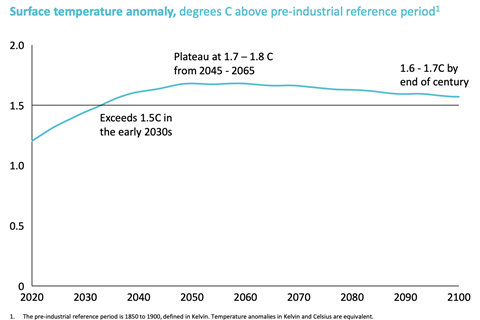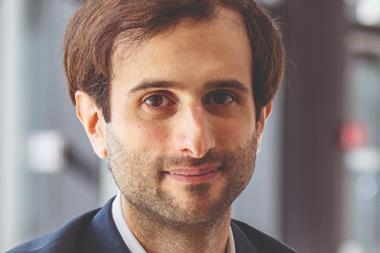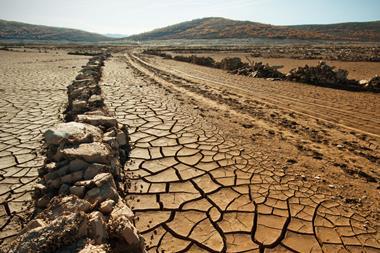The Paris Agreement goal of limiting temperature increase to “well below 2°C” above pre-industrial levels is likely to be achieved, according to the Inevitable Policy Response (IPR), a climate transition forecasting consortium focussed on serving institutional investors.
The consortium, whose approach is conceptually distinct from that of scenarios produced by the International Energy Agency (IEA) or the Intergovernmental Panel on Climate Change, sees temperatures peaking at 1.7°-1.8°C by the 2040s, with net zero carbon dioxide emissions by 2060 and net zero greenhouse gas emissions by 2080.
Efforts will continue towards the higher ambition goal of 1.5°C in light of the effects of breaching this lower threshold, in the 2030s, and the 1.5°C goal could be reached by the 2120s through carbon removals, according to the consortium, which was commissioned by the Principles for Responsible Investment (PRI) in 2018.
A few days after the IPR published its new forecast, the IEA released an update of its landmark net zero roadmap of 2021, saying that the path to limiting global temperature rise to 1.5°C had narrowed but was still open due to record growth of key clean energy technologies.
In contrast to the IPR, the IEA produces scenarios working backwards from a hypothetical outcome and doesn’t model land. The stance on keeping warming to 1.5°C is a major difference between the two climate analyses, but Jakob Thomä, project director of the IPR, said that a common point is the acknowledgement of “climate policy accelerating like crazy”.

For the IPR this increasingly highlights that the central climate outcome is now 1.8°C warming.
“The big story of the last two-and-a-half years, and the one that investors have been missing a trick on, is that 2°C is becoming the new 4°C,” Thomä told IPE.
“The 1.5°C to 2°C world is the world investors should focus on, and realistically 1.7°C to 2°C because that’s the corridor in which climate policies are operating in, and where the climate damages I think are fundamentally underappreciated.”
Land ‘the crucial battleground’
The IPR’s forecast is informed by live tracking of over 300 climate policies over the past two years, as well as input from over 100 climate policy experts across 12 countries.
Key findings include that in emission terms, over two-thirds of the global policy gap is concentrated in three areas: coal power in China, coal power in India, and overall policy in Russia.
Because social, geopolitical and nature “guardrails” will become a key part of the transition, the forecast sees China reaching near zero coal power emissions by 2045 but maintaining 400 GW of coal power in strategic reserves.
“This new 2023 forecast from IPR demonstrates the economic transition to net zero is well underway”
Nathan Fabian, chief sustainable systems officer at the PRI
The IPR also sees land becoming “the crucial battleground” for reaching climate goals over the next decades, both as a carbon sink and as the source of a growing share of emissions, with more than 20% of greenhouse gas emissions linked to ruminant meat by 2050, despite representing only around 10% of food intake.
Another key element of the forecast is that changing policy dynamics in Brazil and Indonesia are predicted to lead to an effective end to deforestation in both countries by 2030.
Bioenergy carbon capture and storage (BECCS), meanwhile, “does not appear as a significant long-term solution”, according to the IPR, but the impacts of breaching 1.5°C will drive policymakers to invest heavily in negative emissions technologies.
It forecasts that these could remove 5 Gt CO2/year in the latter half of the century, reducing temperatures below 1.7°C by the end of the century.
“This new 2023 forecast from IPR demonstrates the economic transition to net zero is well underway,” said Nathan Fabian, chief sustainable systems officer at the PRI.
“It offers clarity on where, when, and how policies are expected to accelerate in response to growing climate risks this decade and beyond. We encourage institutional investors to examine its findings carefully and consider the implications for their strategies.”
Strategic partners rejig
The IPR’s latest forecast comes shortly after APG, the major Dutch pension investor, became a “strategic partner” to the consortium. A spokesperson for APG told IPE that the pension investor was assessing how it can use IPR data to support its business.
The IPR introduced strategic partners in 2021. Since then Temasek, the Singaporean sovereign wealth fund, has also come on board, although BlackRock and Nuveen have exited.
This summer BlackRock unveiled its own forecast of how the low-carbon transition could unfold, the BlackRock Investment Institute Transition Scenario (BIITS).
The latest digital edition of IPE’s magazine is now available





























No comments yet